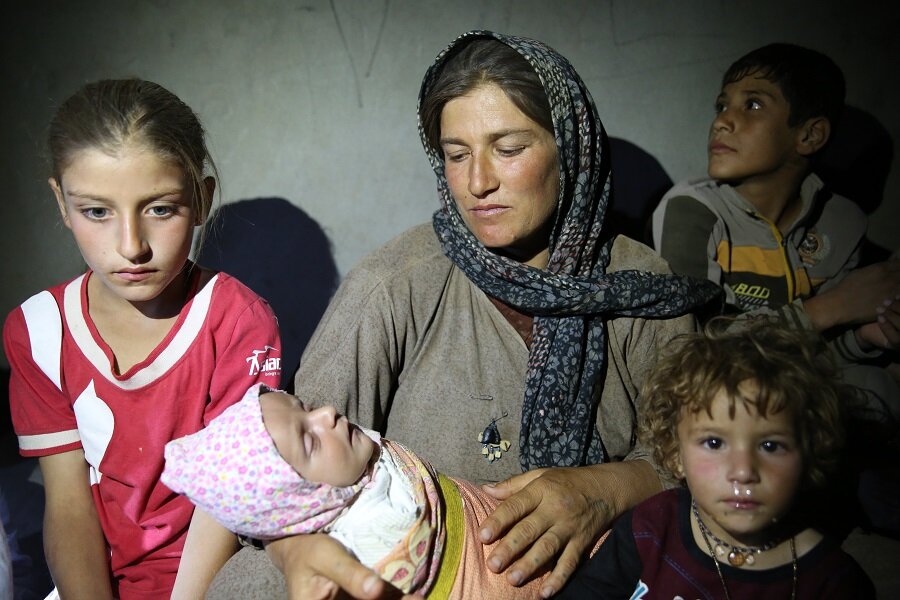A sanctuary for Iraqi Yazidis – and a plea for Obama's intervention
Loading...
| Sheikhan District, Iraq
The way Baba Sheikh sees it, there are only two options left to save Iraqi’s persecuted Yazidi minority from certain death at the hands of the self-declared Islamic State: Either evacuate Iraq en masse or have international peacekeepers carve out protected territory.
“The important thing is that our people are saved,” says Baba Sheikh, the spiritual leader of the Yazidi ethno-religious minority, whose desperate plight helped galvanized the Obama administration into action last week.
US air strikes, and Kurdish peshmerga forces, have partially broken a siege on Mount Sinjar, where tens of thousands of Yazidis had fled. The United Nations' refugee agency said Tuesday that around 35,000 people had crossed into Kurdish-controlled Dohuk in the past 72 hours.
Some of the displaced have reached Sheikhan district and taken refuge in Lalish, home to the tomb of the main figure of the Yazidi faith. For now, they are safe. But Derman Rasha Adi, a member of the peshmerga forces who has overseen security here for a decade, says IS forces are just 15 miles away.
“The Peshmerga are positioned in strategic locations to block their passage, but in all honesty there is no such thing as safety in this situation,” he says.
Sheikhan was home to 16,000 people before the start of the IS assault last month. Today fewer than 500 residents remain, all men who've stayed to protect their homes. The rest of the town's residents are now in areas where Iraqi Kurdish forces are firmly in control.
Dressed in a white robe held together at the waist by a black rope, the sheikh, whose given name is Khurto Hajj Ismail, stares into space, the fatigue of eight sleepless nights kicking in. He is a man on a mission who relays the same plea to anyone who will listen, from peshmerga commanders to Western diplomats and journalists.
“We are calling for a buffer zone patrolled by international forces or the mass relocation of Yazidis abroad,” he says. “The Islamic State is the most dangerous and unjust terrorist group in the world – they kill women, men and children without cause. But when it comes to the Yazidis, they pose the highest threat. They do not give them the a chance to convert, the only option is death."
Yazidi leaders claim there are 600,000 members of the faith in Iraq. There are also Yazidis in Iran, Turkey, Syria and Armenia and immigrant populations in Germany, Canada and Russia. In Iraq, Yazidis are concentrated in Sinjar, now under attack by the Islamic State, as well as Sheikhan, where Yazidis undertake pilgrimages to Lalish temple.
American air strikes
In recent days, US fighter jets and drones have destroyed several armored vehicles used by the Islamic State, formerly known as ISIS, which calls the Yazidis "devil-worshipers" who must convert to Islam or face extermination. President Obama has said the US was intervening to prevent a "potential genocide" of Yazidis.
“This marks the 73rd genocide in our history. It’s the worst so far,” says Sheikhan’s mayor Mamo al-Bagsri, who now wears a pistol at his waist. Like the sheikh, Mr. Bagsiri is pushing for an expanded US war effort in the region, even though Obama has insisted that no combat troops will be deployed.
“No one can save the Yazidis (but) the Americans. Unless the Americans act, the Yazidis will disappear," says Mr. Bagsiri. "The Americans were able to kill Al Qaeda chief Osama Bin Laden in Afghanistan, (so they) should surely be able to tackle a few members of IS on Sinjar mountain."
Sheikhan means the land of the Sheikhs. In an echo of the Muslim pilgrimage to Mecca, Yazidis are expected to make a six-day pilgrimage to visit the tomb of Sheikh Adi ibn Musafir in Lalish.
Now, the sanctuary has been turned into a shelter for Yazidis, mostly from IS-controlled Sinjar. They begun arriving here on Sunday, traveling by foot and on trucks, after Kurdish forces opened an escape route from the area via Syria.
Arduous overland journey
For the 1,600 Yazidis who arrived in the last 48 hours, the temple was an obvious destination. “We have no other place to go but this temple,” says Zeido Mersa, who arrived on Monday along with his wife and ten children, the youngest only 40-days-old.
He made the decision to flee when mortars began landing close to his home. “I am scared that the Islamic State can reach us even here,” he says.
His brother, Walid, lies splayed on the floor fanning the soles of his blistered feet. The family worries about Zeido's wheelchair-bound mother who was left behind with a brother when they crossed the mountain. “They will probably die of thirst, hunger and exhaustion,” says Walid.
The new arrivals said they started walking before dawn after Syrian Kurdish forces gave them the green light. "The Islamic State is also present in Syria so we pushed on to this temple. It is the only relatively safe place because it is in a Kurdish area,” says Khader, another Sinjar refugee.
Khader’s wife Zahra clutches their six-year-old daughter Maya in a tight embrace, a small comfort after a harsh journey. “The only feeling that runs through me is fear. We have nothing left, no safety, no food, no water. Just the clothes on our back,” she says.








